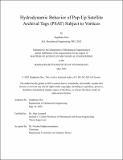| dc.contributor.advisor | Leonard, John | |
| dc.contributor.author | Hoo, Stephanie | |
| dc.date.accessioned | 2025-10-29T17:40:52Z | |
| dc.date.available | 2025-10-29T17:40:52Z | |
| dc.date.issued | 2025-05 | |
| dc.date.submitted | 2025-06-26T14:15:09.959Z | |
| dc.identifier.uri | https://hdl.handle.net/1721.1/163432 | |
| dc.description.abstract | Pop-up Satellite Archival Tags (PSATs) are a combination of satellite and archival tags used by marine biologists to collect large scale movement and behavioral data of large pelagic life for up to two years [1]. However, current commercial PSATs have an unusually high failure rate when tagged on tuna and cost upwards of $4000, making it both difficult and expensive to collect data [14]. Upon investigation, the top two failure modes of tuna-affixed PSATs have been identified as drag from movement/tissue healing and pressure cycling [14]. Current commercial PSAT manufacturers do not account for the vortices shed by fish when testing their designs— a large oversight that could account for their high failure rate [15]. The work herein determined the effects of vortex shedding on PSAT hydrodynamic behavior, used these results to inform the design of novel PSAT body shapes, and conducted a head-to-head comparison of these designs with existing commercial PSATs. | |
| dc.publisher | Massachusetts Institute of Technology | |
| dc.rights | Attribution-NonCommercial-NoDerivatives 4.0 International (CC BY-NC-ND 4.0) | |
| dc.rights | Copyright retained by author(s) | |
| dc.rights.uri | https://creativecommons.org/licenses/by-nc-nd/4.0/ | |
| dc.title | Hydrodynamic Behavior of Pop-Up Satellite Archival Tags (PSAT) Subject to Vortices | |
| dc.type | Thesis | |
| dc.description.degree | S.M. | |
| dc.contributor.department | Massachusetts Institute of Technology. Department of Mechanical Engineering | |
| mit.thesis.degree | Master | |
| thesis.degree.name | Master of Science in Mechanical Engineering | |
